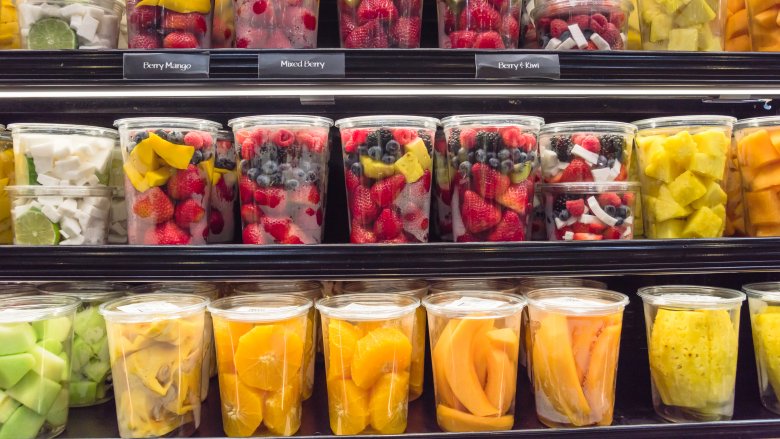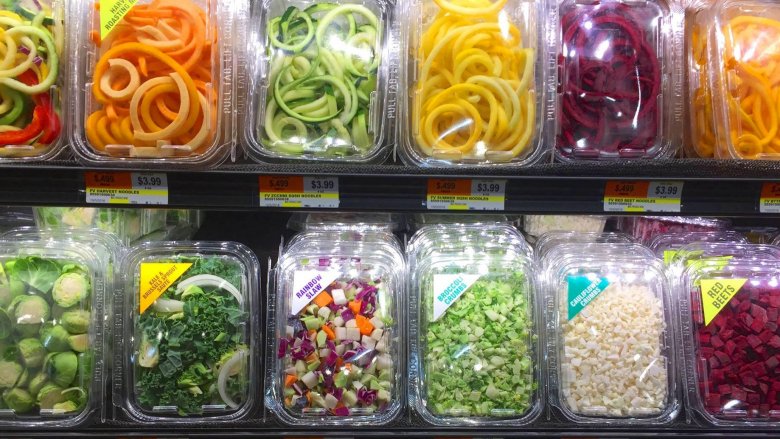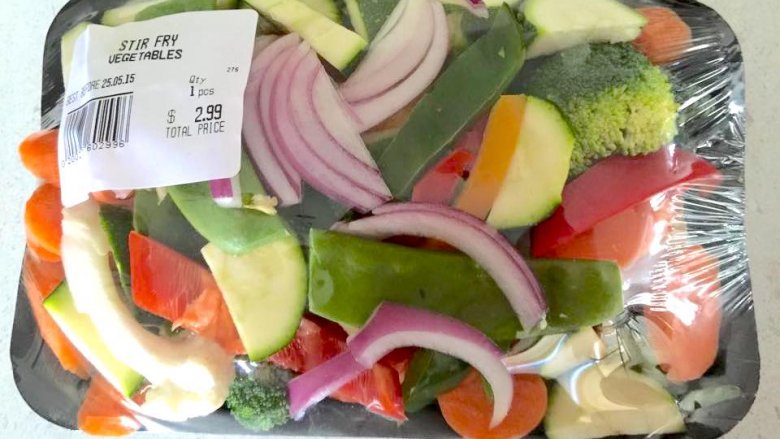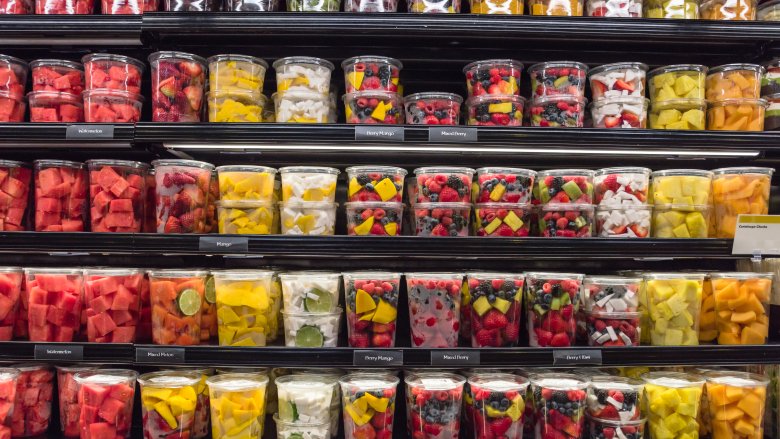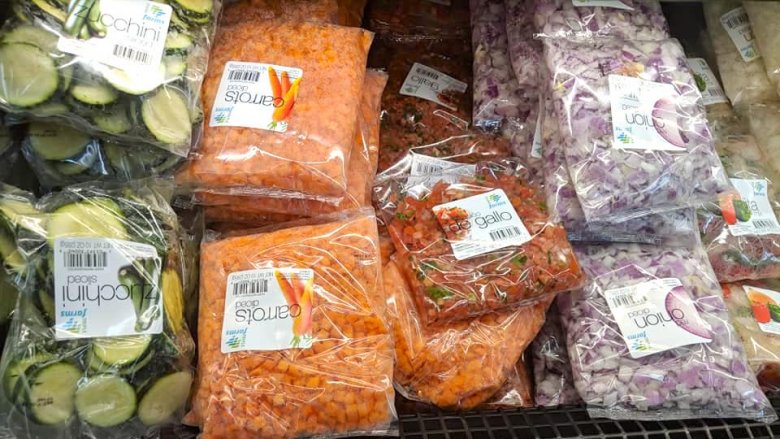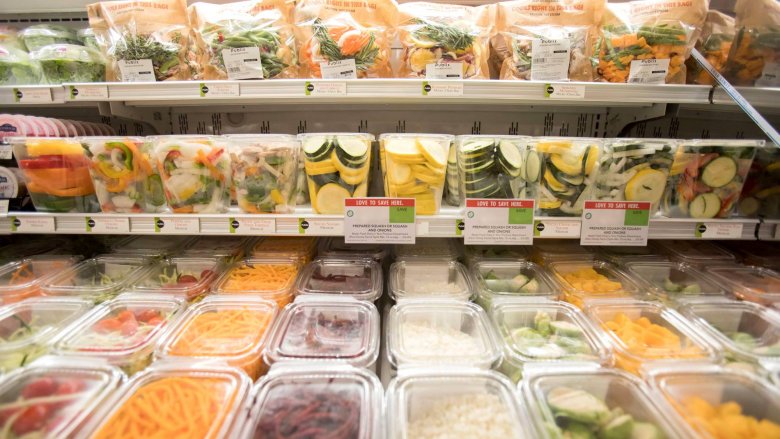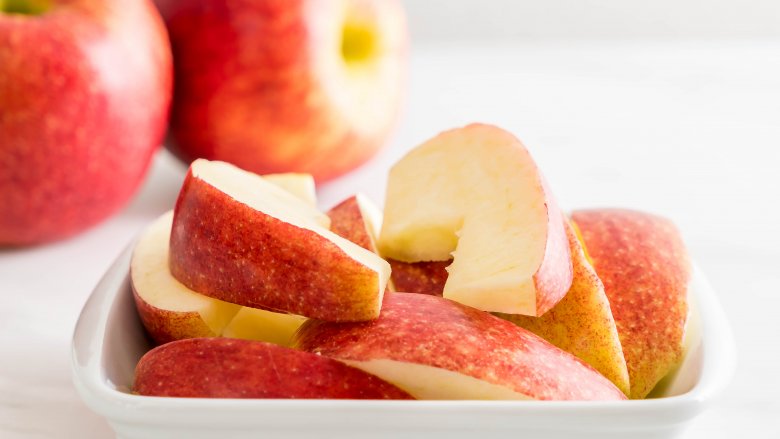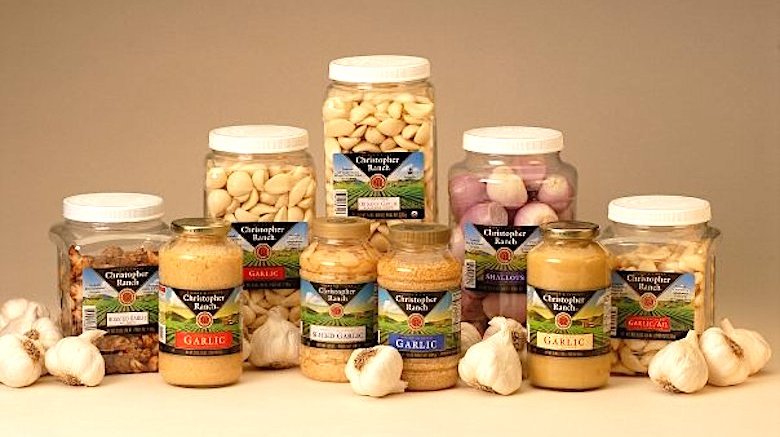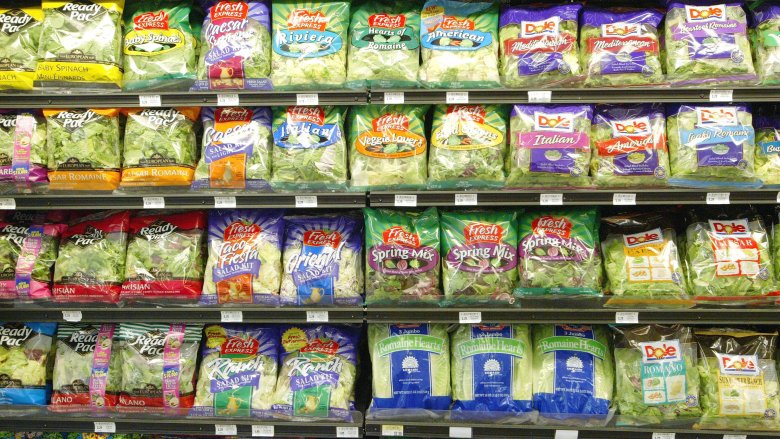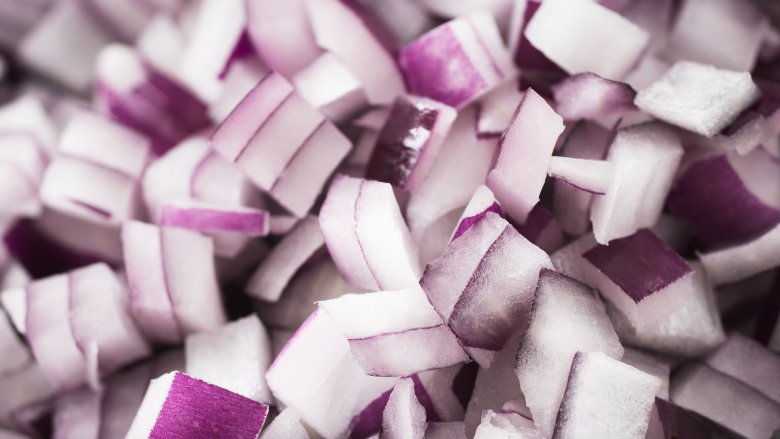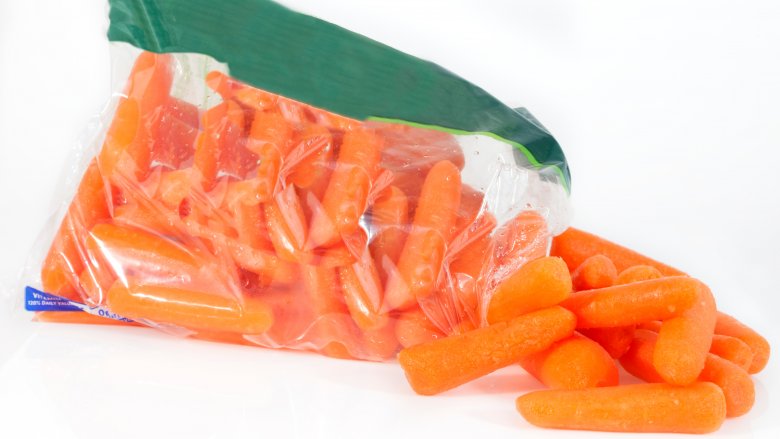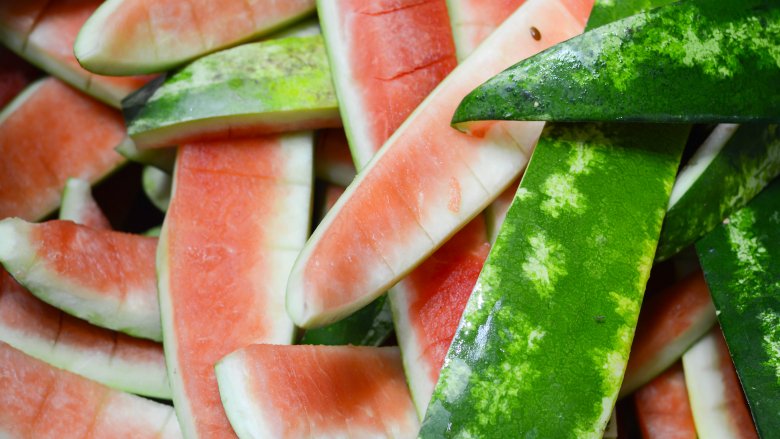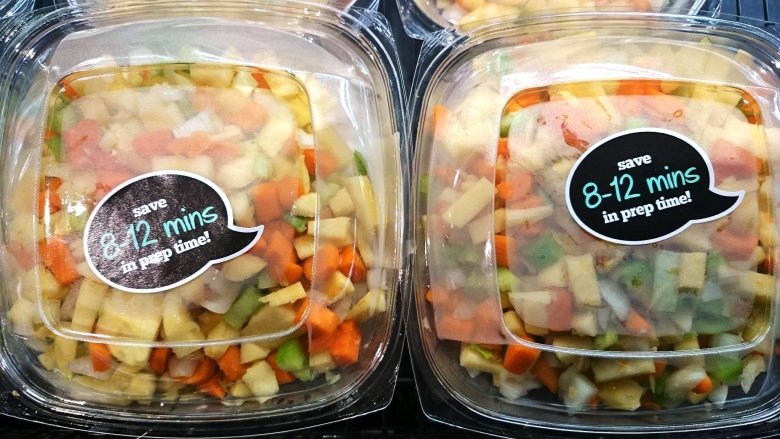The Real Reason You Should Never Buy Pre-Cut Fruit And Vegetables
Wander over to the refrigerated wall in any produce department and you've got your pick of pre-cut fruit. You'll find melon, apples, berries, and citrus; already chopped and mixed onions, carrots, and celery; bagged greens and shredded lettuce; and plenty of other pre-sliced and diced items. We live in a world where, if we have no desire to do so, we'd never have to pick up a knife again to prep our produce. Instant snacks, instant mirepoix, instant salad — it's all there and ready to be eaten or used at a moment's notice. Sure, it's convenient, but at what cost?
It turns out it's not just the higher price of already prepped produce that makes it a questionable choice, although that alone is definitely reason enough to skip it. There are plenty of other good reasons why those pre-packaged items are best kept out of your cart and left on the grocery store shelf. From nutrient loss to anti-browning dips and more, here's the skinny on pre-cut fruit and veggies.
They're way more expensive
This probably won't come as much of a surprise — we known that any convenience item is likely going to cost more than something we have to prepare ourselves. What might surprise you, though, is just how much higher the cost of pre-cut produce is compared to whole fruits and veggies.
In 2018, Vice did a comparison to see how much you could save by forgoing the pre-cut, pre-packaged stuff, and concluded that the average consumer would be about $100 richer each month by doing that food prep themselves. The price differences between whole and chunked produce are staggering across the board, but some of the numbers will blow your mind. Red onions at Walmart, for instance, run 49 cents per pound. Buy them pre-diced, and you're looking at an astounding $4 per pound. At Safeway, you can grab whole butternut squash for $1.29 per pound, or go for the chunked at $4.80 per pound. How about a head of romaine from Peapod? That'll be $1.99, or if you prefer a 22-ounce prepared bag, you'll pay $3.99.
Seeing the raw data makes it pretty clear: Not having to peel, slice, and dice is nice, but it'll cost you. A lot.
They're not as good for you
You're probably wondering how pre-cut fruit and veggies could possibly be bad for you. Well, technically, they're not bad, they're just not as good. Pre-cut fruit and veggies are obviously still fruit and veggies, which means they're a more nutritious choice than, say, a candy bar, but if you're looking for the most bang for your buck in the vitamin department, the prepared stuff isn't where you should turn.
Former grocery store dietitian Caroline West Passerrello told Men's Health, "Cutting fruits or vegetables exposes them to oxygen and light, and sometimes heat, all of which affect vitamin retention in food." She explained that because cut produce loses water faster, it means that water soluble vitamins like B and C will also evaporate faster.
We're not just talking about pre-cut melon and butternut squash, either. Produce that might get peeled unnecessarily, like carrots, cucumber, or potatoes, lose the nutrients contained in their outer layers. As handy as those uniform already-cut carrot sticks might be, once they're prepped and packaged they've been stripped of perfectly good fiber and start losing vitamins fast.
They could make you sick
Washing whole produce that has a protective rind or peel might seem like an annoying extra step to take before you start slicing and dicing, but there's a good reason for it: You're washing away any bacteria that might by lingering on the surface before it can get to the flesh, which is why pre-cut fruit can pose a risk when it comes to foodborne illness.
After tainted pre-cut melon caused a widespread salmonella outbreak in 2018, professor of food science Keith Warriner told Global News, "The problem with processed produce is that much like when you get a scratch on your skin, once it's been cut, it loses a layer of protection and is exposed to [possible contamination]. Melons, in particular, are an extreme example because their flesh is the best growth medium for salmonella." The reason they're so dangerous is because of where they're grown —in the ground — which means their skins could be contaminated with several pathogens, any of which could be transferred through to the flesh with a knife.
"Once the contamination is inside the fruit, it's an element of time because salmonella can double every 30 minutes," added Warriner.
According to Consumer Reports, pre-cut produce is "more likely to be contaminated with bacteria." Commercial processing facilities risk cross contamination because of how many fruits and vegetables are being handled at once, and consumers have no way of knowing if the prep areas, surfaces, or utensils are being sanitized properly.
They have a shorter shelf life
We've all put off cutting open a giant watermelon for a few too many days, and were probably surprised when, more than a week later, it was still good. This is the beauty of whole fruits and vegetables. See, that whole watermelon will last up to 10 days on the counter, and up to three weeks in the fridge. But cut? You're looking at five days max before it's a puddle of pink mush.
This is due to its respiration rate, which is raised as soon as you cut into fruits and veggies. Respiration is the breaking down of sugars within the produce, a process that releases carbon dioxide, which in turn breaks down the flesh and not only leads to faster spoilage, but also an undesirable change in flavor and texture. The smaller the slice, dice, or cube, the faster the respiration rate, and, you guessed it, the faster it goes bad. Pre-chopped onions don't sound like such a good idea now, do they?
They have a bigger carbon footprint
The wonderful thing about many whole fruits and vegetables is that they come in their own natural, protective packaging. Rinds, peels, skins — they can all be put in the compost bin. Pre-cut produce, on the other hand, all naked and vulnerable, needs man-made protection, and that usually comes in the form of plastic containers. Aren't they recyclable? Well, they sometimes say they're recyclable, but according to National Geographic in 2018, an astounding 91 percent of plastic isn't actually recycled, and instead ends up in landfills and worst of all, the ocean.
Plastic waste aside, pre-cut produce is basically the opposite of local, farm-to-table fare, and comes with a larger carbon footprint than whole fruits and vegetables. That's because it requires processing, packing, and eventually transportation, along with constant refrigeration throughout the entire process, all of which use a lot of energy. And you can be fairly certain that all those clamshells full of fruits and veggies didn't come from within a three-mile radius of your city. Okay, okay, not all whole produce at the grocery store is local, but at least it doesn't come encased in plastic, even if it is from four states away.
Apples might be dipped in a preservative solution
Have you ever stopped to think about the fact that when you slice up an apple at home, it starts to turn brown approximately 1.7 seconds after you cut it, but somehow, some way, packaged apple slices at the grocery store seem to have an indefinite shelf life, with no discoloration in sight? No, the pre-sliced apples aren't some mutant breed known for their anti-browning properties — they've actually been coated in a solution to keep them looking their best.
This is the same phenomenon that explains why the apples in McDonald's Happy Meals look perpetually fresh — they're all dipped in a solution of calcium salts and vitamin C, called NatureSeal, which heads off oxidation and preserves the color and crispness of cut apple slices for an astounding 21 days. Now, according to the FDA, this rinse, also known as calcium ascorbate, is considered safe for human consumption, but if you take exception to having anything other than "apples" listed on the ingredient list of your, you know... fresh apples, then you might want to reconsider those pre-sliced packages. Plus, don't 21 day old apples just sound kinda gross?
Pre-peeled and pre-minced garlic can be dicey
We get it — peeling and chopping garlic can be a tedious task, not to mention how unbelievably sticky (and stinky) your hands will be when you're done. But as tempting as it might be to reach for those handy jars of pre-minced garlic or those bags full of already peeled garlic, don't.
Even Rachael Ray Every Day — home to plenty of 30 minute meals and smart shortcuts — advises against the jarred stuff. That's because, thanks to heat pasteurization, the flavor may suffer, and what good is garlic if it's not smack-you-in-the-face potent? Then there's the matter of it containing chemicals like bleach, which might be used to whiten imported garlic. Do you really want "bleach" included in your dinner's ingredient list, even if it does save you time?
As for pre-peeled garlic, that's a no-go, too. According to the New York Post, reporting on the Netflix documentary series Rotten, about 90 percent of the world's garlic comes from China, and aside from concerns that it's contaminated and could be polluted with heavy metals, there's also a matter of how the garlic is processed. Chinese prisoners are responsible for most of the pre-peeled garlic we see on store shelves, and the job isn't easy. In doing this painstaking task, the prisoners' fingernails fall off, and they're left to peel the garlic with their teeth. Not only is it inhumane, but it also makes it illegal to import. Just say no to bootleg garlic.
Even packaged salads and greens are sketchy
If there's one convenience item that's worth buying, it's got to be those bags of already prepped lettuce, cabbage, spinach, and other leafy greens, right? Sorry to dash your dreams, but those bagged delights fall into the same category as pre-cut fruits and veggies, with their antioxidant loss, bigger carbon footprint, and foodborne illness potential.
But bagged greens are usually triple washed, so what gives?
Yes, most bagged greens are triple washed, which, by the way, means a whole lot of H2O going down the drain, but here's the kicker — they might not be all that clean after all. In a 2015 study, engineers at the University of California, Riverside found that after spinach was rinsed in a low bleach condition "upwards of 90 percent of adhered bacteria were observed to remain attached to and survive on the leaf surface." Researcher Nichola M. Kinsinger explained, "In a sense the leaf is protecting the bacteria and allowing it to spread."
Add to that, says dietitian Caroline West Passerrello, the fact that those bags are like an incubator for e. coli, salmonella, and listeria because they give the bacteria "a warm, moist, and sealed environment" to thrive in. And then to make it even worse, she told Men's Health, "Torn leaves are more likely to contain bacteria because there are more edges to contaminate." All good reasons to bust out the salad spinner.
Are pre-cut onions really poisonous?
The internet is very good at spreading misinformation, and the masses love nothing more than a juicy rumor, whether it be about celebrities or how already-cut onions are actually poisonous and will definitely make you sick. According to Cooking Light, the internet is rife with statements like, "Onions are a huge magnet for bacteria, especially uncooked onions. You should never plan to keep a portion of a sliced onion. It's not even safe if you put it in a zip-lock bag and put it in your refrigerator." So is imminent food poisoning really the reason you should skip pre-cut onions?
No. But what about that persistent rumor, you ask? Total bunk. Cooking Light spoke to food safety expert Ellen Steinberg who said, "There is no validity [to this myth] at all." It turns out that cut onions actually contain compounds that have antibacterial properties. Addressing this very claim, the National Onion Association confirmed: "...when cut, onions release compounds that do not promote pathogen growth. The Center for Food Safety at the University of Georgia states, juice released from cut onion is known to kill or inhibit the growth of several types of microorganisms, including some of those capable of causing food poisoning in humans."
The real reason you should skip pre-cut onions because they're probably dried out, they won't be as potent or flavorful, and because it's just not that hard to cut up an onion.
What about that white film on baby carrots?
It can seem like baby carrots get that weird white cast before you even get them home from the grocery store. What gives? Is it safe to eat? Are we chomping on chemical-coated root vegetables? Yes and no.
Baby carrots are, in fact, rinsed in an antimicrobial water solution that does contain a small amount of chlorine, but it's considered safe by the FDA, and is actually a requirement in place to reduce pathogens and limit foodborne illness. The carrots are rinsed in plain tap water as a final step, but if you're opposed to ingesting something that's been in contact with chlorine, it might be something to keep in mind (though for what it's worth, many types of prepared produce you're eating are processed this way).
But that slightly chlorinated rinse is not what's responsible for the white blush you see on baby carrots — that's just a telltale sign of plain ol' dehydration. Once baby carrots, which are made from larger carrots, get pared down and stripped of their protective outer layer, they start to dry out. It's as simple as that. While you can rest easy knowing the white stuff isn't chemicals, think about this: Carrots are already pretty dry as it is... do you really want to snack on an even drier carrot?
You're missing out on making this breakfast treat
Obviously, when you buy pre-cut watermelon, it comes to you not in its original bright green packaging as nature intended, but in a plastic container with all traces of rind removed. According to Extra Crispy's Kat Kinsman, this is reason enough to skip the prepared stuff.
When answering the question, "Should I buy pre-cut melon?" she acknowledges that yes, eating a huge watermelon can be quite a commitment, but says that opting for pre-cut means "you will be depriving yourself of the opportunity to make watermelon rind preserves, which is the finest breakfast condiment known to mankind."
Say what? That inedible, unpalatable part of the watermelon is something we should be eating? Apparently so. Kinsman promises that these preserves, swimming in a gingery, lemony scented syrup, are even better than the watermelon itself, and says slathering them on buttered biscuits or toast is one of her favorite breakfasts. It might sound a bit odd, but what do you really have to lose? You were going to toss that rind into the compost bin anyway, and worst case, if you hate it, you're only really out a couple cups of sugar and lemon juice.
But there is one very good reason for pre-cut produce
Before you write off pre-cut fruit and vegetables altogether and start petitioning your local stores to stop carrying it, you should know that there is a very good reason for grocers to continue stocking their shelves with these convenience items. In some cases, it's not about convenience at all — the pre-cut stuff can actually be a lifesaver.
For those with mobility issues, prepared produce can be the difference between making a home-cooked meal or having to rely on frozen foods. Jennifer Hacker, who has peripheral neuropathy and poor grip strength, told NPR, "I have stopped cooking anything I have to chop or slice first." Kim Sauder, who has limited hand dexterity, explains in her blog, Crippled Scholar, "Preparing food with limited mobility is both hugely time consuming and potentially dangerous."
So, before you scoff at the person in front of you loading up the conveyor belt with bagged salad, pre-chopped mirepoix, and already peeled and cubed butternut squash, consider that they may just be taking advantage of products that will actually allow them to do something as simple as cook themselves dinner. In other words, stay in your lane, and not just the grocery checkout kind.
